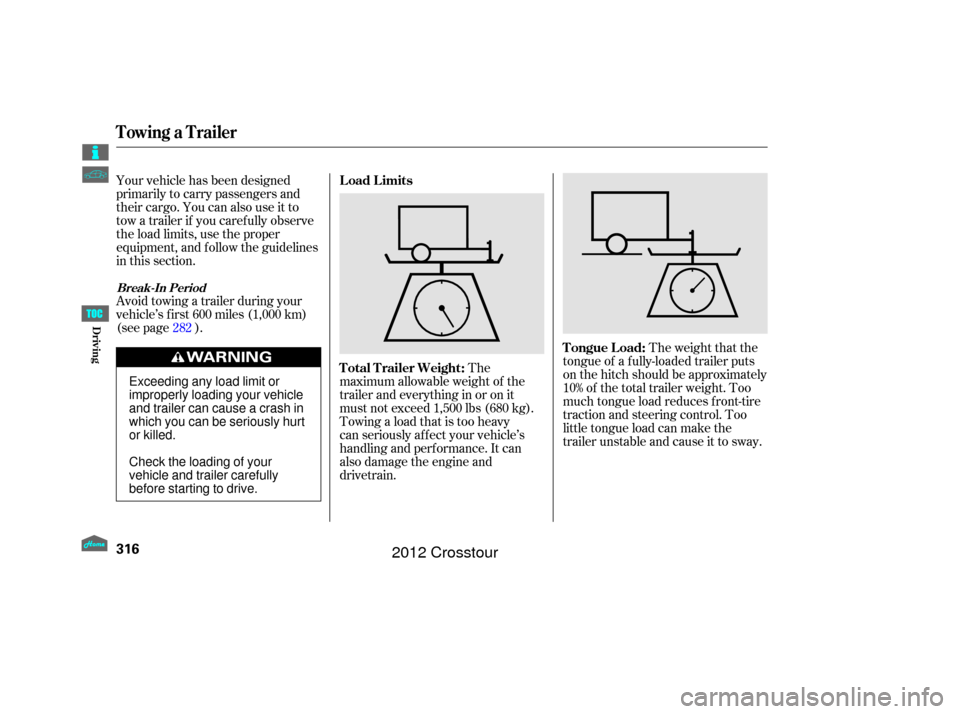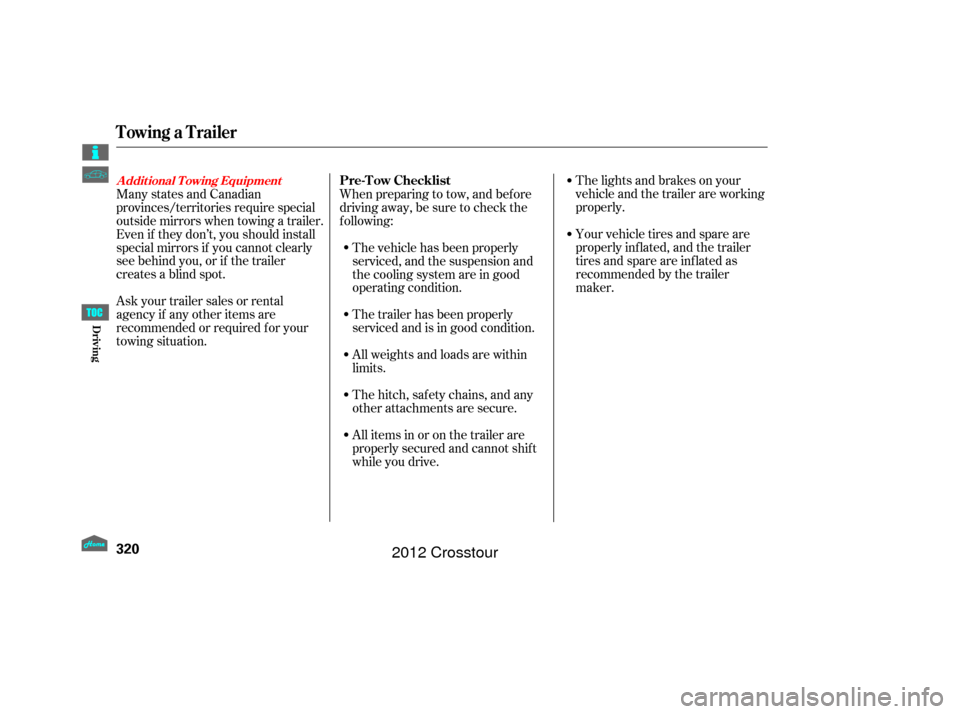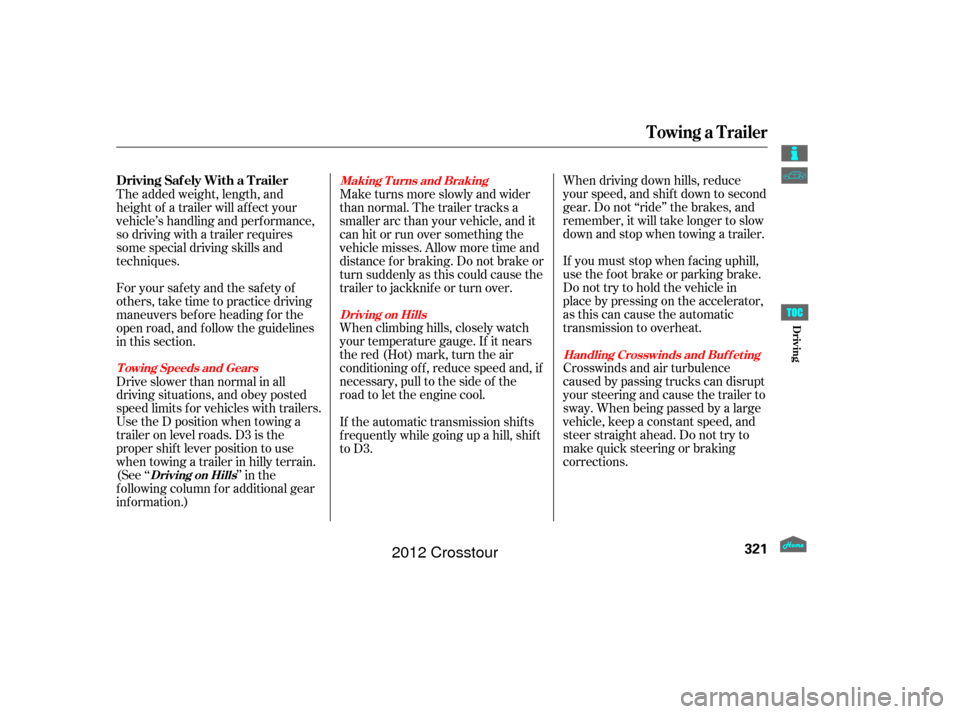Page 302 of 435
If you carry any items on a roof
rack,besurethetotalweightof
the rack and the items does not
exceed 121 lbs (55 kg).The f our hooks can be used to install
a net f or securing items. Each hook
is designed to hold up to 56.2 lbs
(25.5 kg) of weight.
The total weight of the roof rack
and the items should also be
includedinthemaximumload
limits f or your vehicle.
Cargo Hooks
Carrying Cargo
298
FLOOR CARGO HOOK
SIDE CARGO HOOK
Bef ore Driving
2012 Crosstour
Page 320 of 435

Your vehicle has been designed
primarily to carry passengers and
their cargo. You can also use it to
tow a trailer if you caref ully observe
the load limits, use the proper
equipment, and f ollow the guidelines
in this section.
Avoid towing a trailer during your
vehicle’s f irst 600 miles (1,000 km)
(see page ).The
maximum allowable weight of the
trailer and everything in or on it
must not exceed 1,500 lbs (680 kg).
Towing a load that is too heavy
can seriously af f ect your vehicle’s
handling and perf ormance. It can
also damage the engine and
drivetrain. Theweightthatthe
tongue of a f ully-loaded trailer puts
on the hitch should be approximately
10% of the total trailer weight. Too
much tongue load reduces f ront-tire
traction and steering control. Too
little tongue load can make the
trailer unstable and cause it to sway.
282
Break-In Period
Load Limits
T otal T railer Weight:
T ongue L oad:
Towing a Trailer
316
Exceeding any load limit or
improperly loading your vehicle
and trailer can cause a crash in
which you can be seriously hurt
or killed.
Check the loading of your
vehicle and trailer carefully
beforestartingtodrive.
Driving
2012 Crosstour
Page 321 of 435

To achieve a proper tongue load,
start by loading 60% of the load
toward the front of the trailer and
40% toward the rear, then re-adjust
the load as needed.The maximum allowable weight of
the vehicle, all occupants, all
accessories, all cargo, and the
tongue load is: The maximum allowable weight at
the vehicle axles is:
The best way to confirm that all
loads are within limits is to
check them at a public scale. For
public scales in your area, check
your local phone book, or
contact your trailer dealer or
rental agency for assistance.
If you cannot get to a public scale,
you can estimate the total trailer
weight by adding the weight of
your trailer (as quoted by the
manufacturer) with everything
in or on the trailer.
If you normally pull the same load
each time you tow a trailer, you can
use a suitable scale or a special
tongue load gauge to check the
tongue load the first time you set up
a towing combination (a fully loaded
vehicle and trailer), then recheck
the tongue load whenever the
conditions change.
on the f ront axle
on the rear axle
on the f ront axle
on the rear axle
2WD models:
4WD models:
2WD models:
4WD models:
Gross Vehicle Weight Rating
(GVWR): Checking L oads
Gross Axle Weight Rating
(GA WR):
Towing a Trailer
317
4,938 lbs (2,240 kg) 2,623 lbs (1,190 kg)
2,381 lbs (1,080 kg)
5,115 lbs (2,320 kg) 2,668 lbs (1,210 kg)
2,513 lbs (1,140 kg)
Driving
2012 Crosstour
Page 324 of 435

The lights and brakes on your
vehicle and the trailer are working
properly.
Your vehicle tires and spare are
properly inf lated, and the trailer
tires and spare are inflated as
recommended by the trailer
maker.
Askyourtrailersalesorrental
agency if any other items are
recommended or required f or your
towing situation. When preparing to tow, and bef ore
driving away, be sure to check the
f ollowing:
Many states and Canadian
provinces/territories require special
outside mirrors when towing a trailer.
Even if they don’t, you should install
special mirrors if you cannot clearly
see behind you, or if the trailer
creates a blind spot. The vehicle has been properly
serviced, and the suspension and
the cooling system are in good
operating condition.
The trailer has been properly
serviced and is in good condition.
All weights and loads are within
limits.
Thehitch,safetychains,andany
other attachments are secure.
All items in or on the trailer are
properly secured and cannot shif t
while you drive.
Towing a Trailer
A ddit ional T owing EquipmentPre-T ow Checklist
320
Driving
2012 Crosstour
Page 325 of 435

When driving down hills, reduce
your speed, and shif t down to second
gear. Do not ‘‘ride’’ the brakes, and
remember, it will take longer to slow
downandstopwhentowingatrailer.
If youmuststopwhenfacinguphill,
use the f oot brake or parking brake.
Do not try to hold the vehicle in
place by pressing on the accelerator,
as this can cause the automatic
transmission to overheat.
Crosswinds and air turbulence
caused by passing trucks can disrupt
your steering and cause the trailer to
sway. When being passed by a large
vehicle, keep a constant speed, and
steer straight ahead. Do not try to
make quick steering or braking
corrections.
Maketurnsmoreslowlyandwider
than normal. The trailer tracks a
smaller arc than your vehicle, and it
canhitorrunoversomethingthe
vehicle misses. Allow more time and
distance f or braking. Do not brake or
turn suddenly as this could cause the
trailer to jackknif e or turn over.
When climbing hills, closely watch
your temperature gauge. If it nears
the red (Hot) mark, turn the air
conditioning of f , reduce speed and, if
necessary, pull to the side of the
road to let the engine cool.
The added weight, length, and
height of a trailer will af f ect your
vehicle’s handling and perf ormance,
so driving with a trailer requires
some special driving skills and
techniques.
Foryoursafetyandthesafetyof
others,taketimetopracticedriving
maneuvers bef ore heading f or the
open road, and f ollow the guidelines
in this section.
Drive slower than normal in all
driving situations, and obey posted
speed limits f or vehicles with trailers.
Use the D position when towing a
trailer on level roads. D3 is the
proper shif t lever position to use
when towing a trailer in hilly terrain.
(See ‘‘
’’ in the
f ollowing column f or additional gear
inf ormation.) If the automatic transmission shifts
f requently while going up a hill, shif t
to D3.
Towing a Trailer
Handling Crosswinds and Buf f et ing
Making T urns and Braking
Driving on Hills
T owing Speeds and Gears
Driving on Hills
Driving Saf ely With a T railer
321
Driving
2012 Crosstour
Page 338 of 435
Your vehicle does not require any oil
additives. Additives may adversely
af f ect the engine or transmission
perf ormance and durability. You may use a synthetic motor oil if
it meets the same requirements
given f or a conventional motor oil: it
displays the API certif ication seal,
and it is the proper weight. You must
f ollow the oil and f ilter change
intervals shown on the information
display.
Honda Motor Oil is the pref erred
0W-20 lubricant f or your vehicle. It is
highly recommended that you use
Honda Motor Oil in your vehicle f or
optimum engine protection. Make
sure the API Certif ication Seal says
‘‘For Gasoline Engines’’.
The oil viscosity or weight is
provided on the container’s label.
0W-20 oil is f ormulated f or year-
round protection of your vehicle to
improve cold weather starting and
f uel economy.
Synthetic Oil
Engine Oil A dditives
A dding Engine Oil
334
API CERTIFICATION SEAL
Ambient Temperature
Maint enance
2012 Crosstour
Page 357 of 435
If your seat belts get dirty, use a sof t
brush with a mixture of mild soap
and warm water to clean them. Do
not use bleach, dye, or cleaning
solvents. Let the belts air-dry bef ore
you use the vehicle.Dirt build-up around the openings of
the seat belt anchors can cause the
belts to retract slowly. Wipe the
openings with a clean cloth
dampened in mild soap and warm
water or isopropyl alcohol.
The driver’s f loor mat that came
with your vehicle hooks over the
f loor mat anchors. This keeps the
f loor mat f rom sliding f orward and
possibly interf ering with the pedals
or making the f ront passenger’s
weight sensors inef f ective.
CONT INUED
2WD models
Cleaning the Seat Belts Floor Mats
Cleaning the Seat Belts, Floor Mats
353
OPENING
Maint enance
2012 Crosstour
Page 358 of 435

This f ilter removes the dust and
pollenthatisbroughtinfromthe
outside through the climate control
system.
Have your dealer replace this filter
when this service is indicated by a
maintenance message on the
inf ormation display. It should be
replaced every 15,000 miles (24,000
km) if you drive primarily in urban
areas that have high concentrations
of soot in the air, or if the f low f rom
theclimatecontrolsystembecomes
less than usual.
If you remove a f loor mat, make sure
tore-anchoritwhenyouputitback
in your vehicle.
If you use a non-Honda f loor mat,
make sure it f its properly and that it
canbeusedwiththefloormat
anchors. Do not put additional f loor
mats on top of the anchored mat.
Make sure the rear f loor mats are
properly positioned. If not, the f loor
mat will interf ere with the seat
operation and make the f ront
passenger’s weight sensors
inef f ective.
When cleaning or replacing, turn the
knob counterclockwise to unhook
the floor mat. The driver’s f loor mat that came
with your vehicle hooks over the
f loor mat anchors. To lock each
anchor, turn the knob clockwise.
This keeps the f loor mat f rom sliding
f orward and possibly interf ering with
the pedals.
4WD models
Floor Mats, Dust and Pollen Filter
Dust and Pollen Filter
354
Unlock Lock
KNOB
ANCHOR
Maint enance
2012 Crosstour